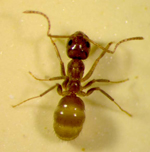SHSU Named Site Of Institute To Study, Control Invasive Species
Updated Sept. 9, 2014
Changes are in bold
Nov. 7, 2011
SHSU Media Contact: Julia May
 |
| The Rasberry crazy ant was discovered in the Houston area in 2005 and is notorious for invading and shorting out electrical equipment. |
(AUSTIN) – Sam Houston State University has been named the location of the Texas Invasive Species Institute (TSIS), the first comprehensive research effort in Texas focused on the early detection and elimination of multiple invasive species.
Texas State University System Chancellor Brian McCall announced the creation of the institute, which will draw from the experience of more than 40 researchers throughout The Texas State University System.
While several agencies and organizations work on the invasive species problem in Texas, TSIS is the first that will establish a comprehensive management plan for multiple species. Using GIS mapping and predictive modeling, TSIS researchers will be able to rapidly identify new and existing invasive species. This information can be used to quickly develop invasive species management plans for Texas and the Gulf Coast region in order to control or eradicate potential threats.
The institute will be located in the laboratories of Sam Houston State University’s Texas Research Institute for Environmental Studies.
“At SHSU we will house staff to facilitate early detection and rapid response efforts,” said Jerry Cook, associate vice president for research and interim dean of SHSU’s College of Sciences.
“Associated with this will be our biological museum holdings which will facilitate identification of species and provide for long-term vouchering of specimens,” he said.
In addition to Cook, several SHSU faculty and research scientists will be actively involved with the operation of the institute, including Autumn Smith, Jack Hill, Chris Wilson, Amber Bartelt.
Individual SHSU researchers have the option of participating on projects, including eight biology faculty and five geographic information system faculty.
Cook was recently appointed as The Texas State University System representative to the board of directors for the Texas Invasive Plant and Pest Council. Among the council’s objectives are to promote awareness and an understanding regarding invasive pests and plants and their control across Texas, and to serve as an advisory council regarding the funding, research, policy and management of invasive pests and plants.
“The Texas State University System has long been a leader in the study and management of invasive species,” said McCall. “By coordinating our research efforts through the institute, we can leverage the experience and resources within our system to help Texas respond rapidly to new threats before they cause widespread damage.”
Due to its geographic relationship to ports, international borders and corridors between states, Texas is a key point of origin for the nation’s new threats of invasive species. To date, more than 800 aquatic and terrestrial species have invaded Texas and more are expected in the years ahead. The impact of these species is far-reaching, including threatening the nation’s food supply, damaging infrastructure, destroying natural resources, reducing water supplies and jeopardizing national security.
“For example, the Rasberry Crazy Ant, which was first discovered near Houston in 2005, has spread to more than 20 counties in Texas and has also been found in Louisiana and Mississippi,” said McCall. “This species develops massive populations that infest and destroy infrastructure. Already, it has attacked electrical equipment at NASA and one company in the chemical industry sustained $1 million in damage to equipment.
“Working with various state agencies and other stakeholders in Texas and beyond, The Texas State University System’s Texas Invasive Species Institute will play a leading role in helping to conserve Texas’ natural resources and lands, and protecting the state’s economy,” McCall said.
The Texas State University System is Texas’s oldest university system and comprises eight institutions stretching from the Big Bend Region to the Louisiana border: Lamar University; Sam Houston State University; Texas State University-San Marcos; Sul Ross State University; Sul Ross State University Rio Grande College; Lamar Institute of Technology; Lamar State College-Orange; and Lamar State College-Port Arthur.
- END -
This page maintained by SHSU's Communications Office:
Assistant Director: Julia May
Writer: Jennifer Gauntt
Located in Administration Building Suite 115
Telephone: 936.294.1836; Fax: 936.294.1834
Please send comments, corrections, news tips to Today@Sam.edu.

 SamWeb
SamWeb My Sam
My Sam E-mail
E-mail

